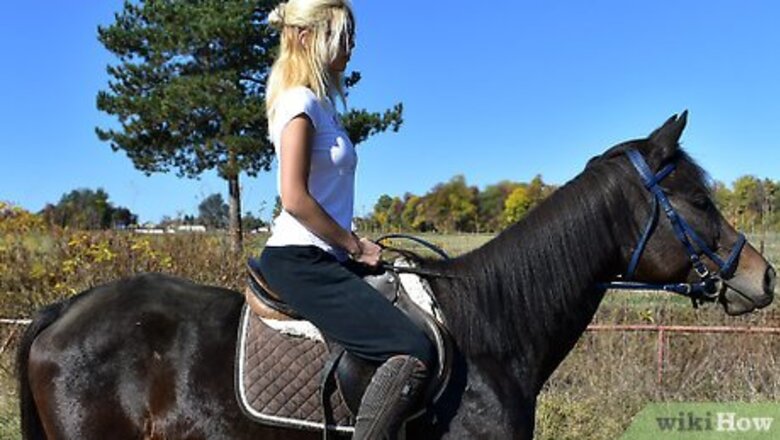
views
Perfecting Your Posture
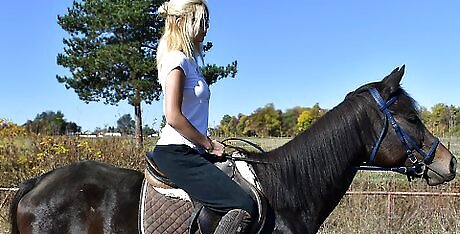
Sit tall and straight with your head, hips, and ankles aligned. Whether you’re riding English or Western style, your posture should be tall, straight, and balanced. Keep your arms relaxed and against your sides, and allow your legs to hang naturally on either side of the horse. If you’re well-balanced, you should be sitting directly over your ankles. This means your ankles, hips, and head form a straight line. If you weren’t on the horse, you’d be able to stand in this position without toppling over.
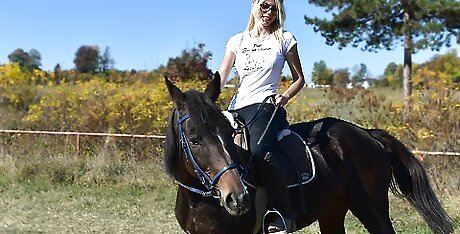
Keep your eyes forward or in the direction you want to move. Locking your eyes on a focal point ahead will help you keep your posture straight and balanced. The better you keep your balance, the more balanced your horse will be. A good rule to remember is the direction you see through the horse’s ears is the direction you’ll go. Lowering your eyes is a bad habit to get into since it's tough to break and can eventually lead to slumping. If you have trouble keeping your eyes up, try focusing on trees or a building’s roofline ahead of you.

Relax your body to absorb the horse’s movement. Remember not to tightly grip with your thighs, knees, or calves. They should rest evenly against your horse's sides as you balance yourself with your seat. Keep your hips, knees, and ankles springy to absorb the jolting movement of the trot. Always do your best to relax when you ride. A tense rider is uncomfortable for the horse.Tip: Think of your hips and legs as connected to the muscles in the horse’s back. Imagine that your hips lift the horse’s back to make it move. Since the horse is in constant motion as it trots, remember that your body must also be in motion.

Place the balls of your feet in the stirrups if you’re using them. If you’re riding with stirrups, keep only the balls of your feet in them. Flex your ankles so your heels are closer to the ground than the balls of your feet. Keep even pressure on the stirrups at all times to maintain your balance. Be sure not to push yourself forward or use the stirrups to bounce up and down when the horse trots.
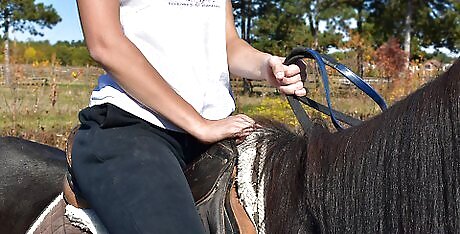
Grasp the reins with your left hand if you’re riding Western style. Hold the reins with your left hand just above and in front of the pommel, which is the raised part at the front of the saddle. Rest your right hand on your thigh, and keep both elbows against your sides. If you’re riding English style, grasp the reins with both hands. Hold your hands just ahead of the saddle and keep your elbows slightly bent, relaxed, and close to your sides. As you sit up straight, your elbows should be aligned with your head.
Posting the Trot
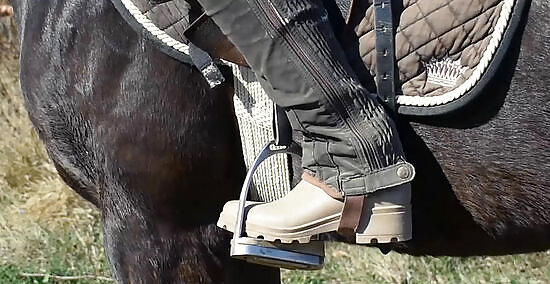
Squeeze your legs or give the horse a light kick to cue it to trot. Start at a lively, balanced walk. When you feel relaxed and balanced on the horse, shorten your reins by 1 to 2 in (2.5 to 5.1 cm), and give the horse brisk squeezes with your legs until it begins trotting. If your horse needs extra encouragement, try saying “Trot!” or give it a quick, gentle kick with your heel. Start at a walk so the horse can get comfortable with you. Once you feel secure and the horse seems calm and willing, cue the trot. A dropped head is the key sign that your horse is relaxed. If it raises its head, feels rigid, or tries to bite at your feet, slow your own breathing and heartbeat, and sooth it by saying “Easy” or “It's okay” in a low, soft, calm voice. Some equestrians prefer not to use kick commands, so check with the horse's trainer or your riding instructor about cuing the trot.Tip: If you feel unbalanced when you’re just starting out, hook a pinky finger around the pommel of your saddle. That way, you won’t pull hard on your horse’s reins and hurt its mouth.
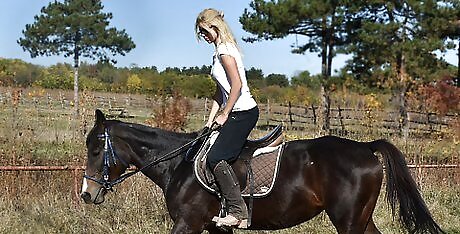
Post forward at a 30-degree angle. Rise upward and forward simultaneously, and keep your spine straight, chest out, and shoulders back. As you post, lean forward about 30 degrees. Allow the horse’s motion to direct your post; remember to think of your core, hips, and legs as an extension of the muscles in the horse’s back. Don’t propel yourself with your feet or legs. You should only rise about 2 inches (5.1 cm) out of the saddle. Bouncing hard or propelling yourself with your feet can hurt your horse.

Sync your posts with the horse’s gait. The trot is known as a two-beat gait; you can count "1-2-1-2" or “clip-clop” as your horse trots. To sync up with its gait, rise up as your horse's outside shoulder (the shoulder closest to the arena or track perimeter) moves forward. When a horse trots, it moves diagonal pairs of legs in unison. First, it sends its left foreleg and right hind leg forward, then it moves its right foreleg and left hind leg.
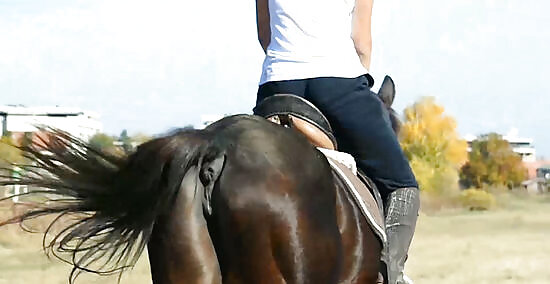
Return to the saddle softly. When you descend from the post, try not to plop hard down onto the horse’s back. The saddle will disperse some of your body weight, but bouncing hard is still uncomfortable for the horse. Rising forward 30 degrees instead of straight up and down can help you avoid bouncing hard on your horse’s back.
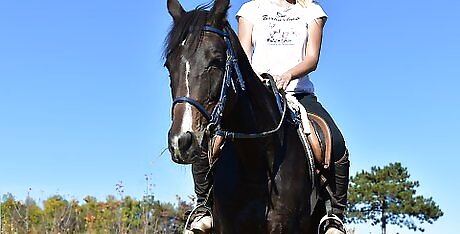
Keep your calves pressed firmly to the horse’s barrel. Your legs should be relaxed; don’t squeeze the horse tightly or use your legs to keep your balance. That said, make sure your calves remain in contact with the horse’s barrel. This will help you avoid involuntary leg movements. If you don’t maintain control over your legs, you could accidentally kick your horse and confuse it.
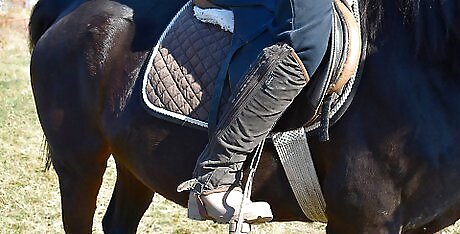
Maintain steady pressure on your stirrups if you’re using them. The pressure on your stirrups should remain steady as you rise and sit. Instead of bracing your ankles and forcing yourself upward, move gently up and down with springy, supple ankles. If you’re riding without stirrups, extend your legs and use your seat to balance. Scrunching up your legs can cause you to tightly grip the horse with your knees and thighs.
Sitting the Trot
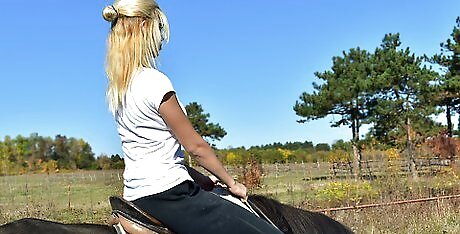
Pull your seat into the deepest part of the saddle. Sit up tall and straight, and bring your rear end as far back into the saddle as you can. Square your shoulders to keep your balance, but be sure to keep your core, hips, and thighs loose so you can follow the horse’s movements. Sitting forward makes it harder to swing your hips in sync with the horse’s gait.
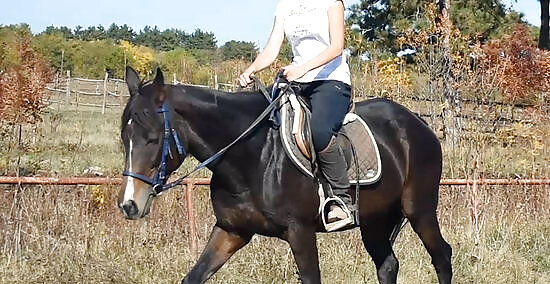
Cue your horse to trot by squeezing your legs or giving it a gentle kick. Allow your horse to get comfortable with you at a lively walk. Shorten the reins by 1 to 2 in (2.5 to 5.1 cm), then squeeze your legs to signal it to trot. If necessary, say “Trot!” or give it a light kick to send it forward. Cue the trot once you feel balanced and secured on your horse. It should seem calm and willing. Its head will bob up and down with its gait but should be in an overall dropped position instead of held erect. If it seems stressed, try to ease your own nerves, and try to soothe the horse by speaking to it in a soft, low, calm voice. Since some equestrians don't like using kick commands, ask the riding instructor or the trainer how to cue your particular horse.
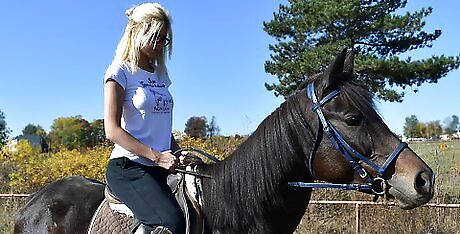
Keep your shoulders squared and spine straight. Maintain your tall posture and keep your head, shoulders, and hips aligned. Keep your torso straight and tall, but remember not to tense your body. Square your shoulders to keep your balance, but try not to be too stiff. Keep your core and legs relaxed to follow the rhythm of the horse’s gait.

Swing your hips in rhythm with the horse’s muscles. Stay connected to the horse and follow its movements with your hips. Swing your hips upward and forward and downward and backward in rhythm with the muscles in the horse’s back. Remember to keep your calves braced (but not locked) against the horse’s barrel so you don’t accidentally kick the horse.Practice this exercise: Sit on a swing, lift your legs off of the ground, and practice moving the swing forward and backward without pumping your legs. Just use the muscles in your hips, lower back, and stomach. These are the same muscles you use to sit the trot.

Avoid pushing off the stirrups if you're using them. Try not to drive into the stirrups or bounce off of them. Instead of digging in your feet, keep your ankles supple to stay in sync with the horse's gait. Try sitting the trot without stirrups. This exercise can help you master proper leg alignment.

















Comments
0 comment